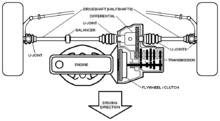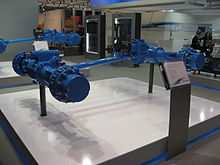Drivetrain

The drivetrain of a motor vehicle is the group of components that deliver power to the driving wheels.[1] This excludes the engine or motor that generates the power. In contrast, the powertrain is considered as including both the engine or motor, and the drivetrain.
Function
The function of the drivetrain is to couple the engine that produces the power to the driving wheels that consume this power. This connection involves physically linking the two components, which may be at opposite ends of the vehicle and so requiring a long propeller shaft or drive shaft. The operating speed of the engine and wheels are also different and must be matched by the correct gear ratio. As the vehicle speed changes, the ideal engine speed must remain approximately constant for efficient operation and so this gearbox ratio must also be changed, either manually, automatically or by an automatic continuous variation.
Components
The precise components of the drivetrain vary, according to the type of vehicle.
Some typical examples:
Manual transmission car
.jpg)
- Engine
- Clutch
- Gearbox or stick-shift transmission
- Overdrive Only rarely fitted
- Propeller shaft
- Rear axle
- Final drive
- Differential
Automatic transmission car
- Engine
- Torque converter
- Transmission
- Propeller shaft
- Rear axle
- Final drive
- Differential
Front-wheel drive car

- Engine
- Clutch
- Transaxle
- Gearbox
- Final drive
- Differential
- Drive shafts and constant-velocity joints to each wheel
Four-wheel drive off-road vehicle

- Engine
- Clutch
- Gearbox
- Transfer box
- Transmission brake
- Propeller shafts, to front and rear
- Front and rear axles
- Final drive
- Locking differential
- Portal gear
See also
- Hybrid vehicle drivetrain, the drivetrain of hybrid vehicles
- Powertrain